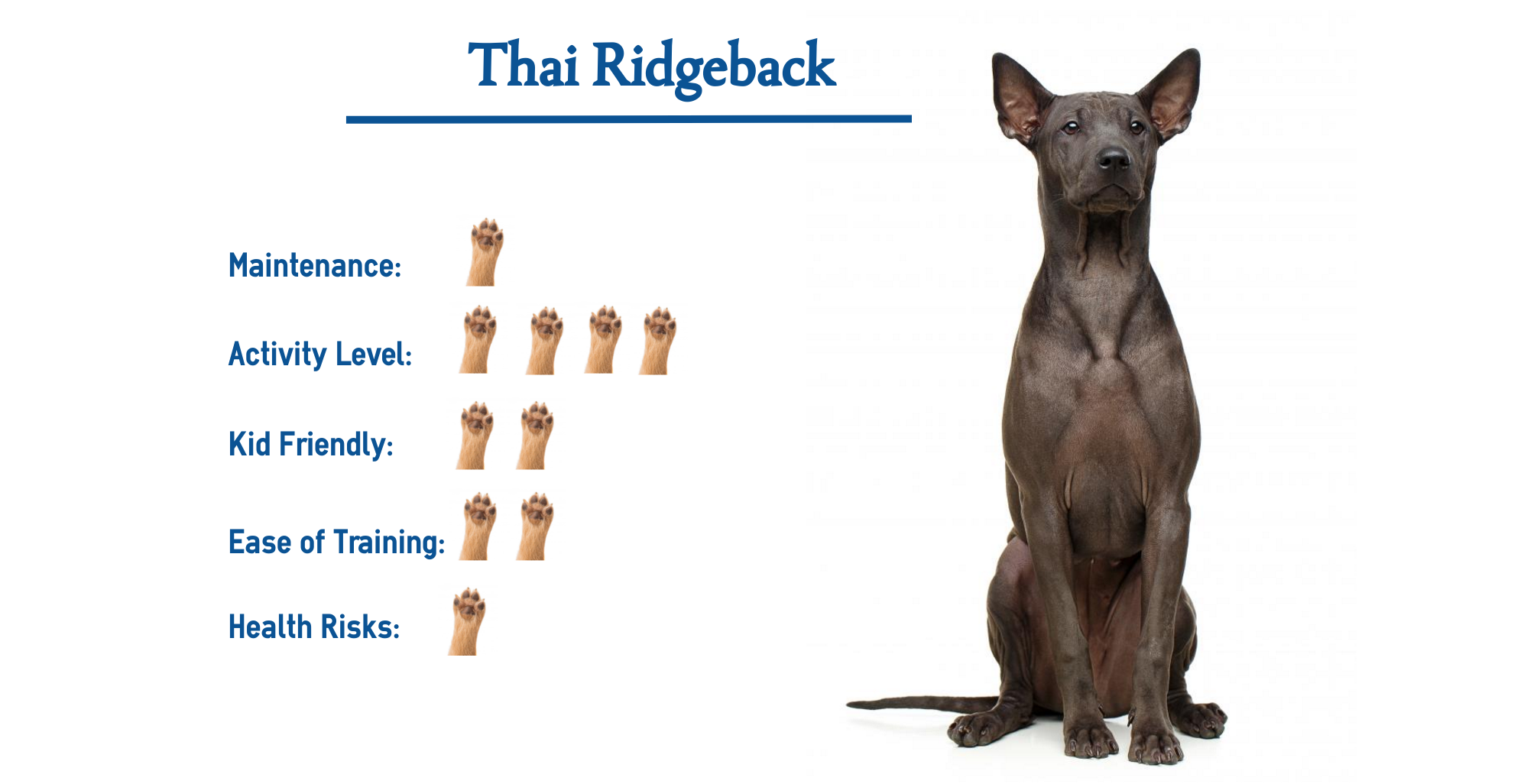Not every day you meet a dog from eastern Thailand, but if you do, it might be the Thai Ridgeback. Reasonably new to America, this fantastic watchdog is alert and ready for an adventure like hunting a wild boar! And while this might not sound like an ideal pet for some, others have learned just how great a family pet these guys can be.
Which is why…
We wanted to take a moment and discuss the Thai Ridgeback dog breed in a bit greater detail. This way, if you ever get an opportunity to make one your own, you’ll know immediately if it will be a good “fit” or not!
So, without further ado, let’s dive right in.
Thai Ridgeback Fast Facts
Country of Origin: Thailand
Original Purpose: Guard Dogs/ Hunt rats & vermin
Height: 20 to 25 inches at the shoulder
Weight: 30 to 55 pounds
Lifespan: 10 to 13 years
Dog Breed Classification: Not “officially” recognized by the American Kennel Club (AKC)
Life Span: 12 to 13 years
Origin of the Thai Ridgeback Dog Breed
Eastern Thailand, otherwise known as Isan, is the home of the Thai Ridgeback. This rural area full of rice paddies is where the Thai Ridgeback worked. Killing off rats and rodents was essential to protecting the crop, as was watching over the whole field. And while these guys are not new to Thailand, they only made their way to America in 1994, so they’re still relatively new to the West. They were first imported by a man by the name of Jack Sterling. He is also responsible for naming them.
The Thai name…
Is Mah Thai Luncg Arn, “mah” means “dog” in Thai? The dogs were first shown in the west at the Cherry Blossom Rare Breed Dog Show in DC.
Physical Characteristics
These dogs have pointed ears and wrinkly foreheads. This dog is a strong-looking dog that has slightly loose skin but a smooth coat and short hair. They have cute, almond-shaped eyes not commonly found among dogs. Their eye color can range from brown to blue.
Standard Colors include Steel grey or silver, black or “blue.” Of course, by blue, we don’t mean bright blue or royal blue, but rather a blue grey. The word “ridgeback” describes a “ridge” of hair growing against the direction of the rest. This occurs along the spine, hence the term ridgeback.
Personality and Temperament
The Thai Ridgeback existed as a watch and hunting dog, not a traditional pet in the US. As a result, this guy is pretty active and loves to jump. Training this dog from the time he’s a puppy is necessary to ensure he’s socialized. If you wait until later in a dog’s life for training, it just might not happen as you’d like. Puppies trained from early on will react well to an even-tempered yet firm owner.
One thing you…
Need to know is that this dog needs adequate exercise. They can live in an apartment life so long as he gets to have fun outdoors, once or preferably twice a day (and we don’t mean for a potty break – we mean proper playing). The need for play is due to their high prey drive. Remember, these dogs are inherently used to hunting small prey to help their farmers.
Similar Breeds
This dog is in a class of its own, but owners who might otherwise opt for a German Shepherd could find a friend in a Thai Ridgeback.
Potential Health Concerns
In general, this dog is very healthy and sturdy. However, it’s important to note that Thailand is very hot, so this dog is used to hot & humid climates. That’s not to say he won’t be able to handle a cold winter, but it’s not going to be his ideal. Florida is a great place to keep this puppy healthy!
Dermoid Sinus…
It is rare but still possible. You may have heard this associated with other ridgebacks, particularly the Rhodesian Ridgeback. And it can happen for the Thai Ridgeback as well. This is a neural tube defect. If the problem is terrible, you might have to opt for surgical treatment.
Dermoid sinus is a genetic defect that breeders can avoid. If the fault is detected, the dog should not be bred anymore, thus eliminating it from further puppy generations. You can ask your breeder for information and family history beforehand to help prevent this. A kennel club can recommend the right breeder.
And while…
This condition may not be life-threatening, but it can become quite expensive, particularly if they become a recurring issue. This is why we here at IndulgeYourPet also recommend that any new pet owner take a moment and see what it might cost for you to purchase a pet insurance policy for your new animal.
Now will a pet insurance policy be suitable for everyone?
No, probably not. But until you fully understand what these policies “will” and “won’t” cover and how much these pet insurance policies cost, how will you know if one might be right for you?
For more information on who we feel currently offers the “best” pet insurance policies out there, we would encourage you to check out our Best Pet Insurance Policies article.



